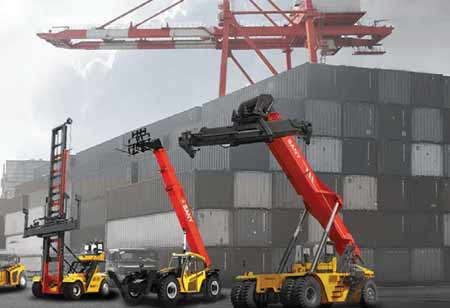THANK YOU FOR SUBSCRIBING
THANK YOU FOR SUBSCRIBING

By
Logistics Transportation Review | Friday, August 15, 2025
Stay ahead of the industry with exclusive feature stories on the top companies, expert insights and the latest news delivered straight to your inbox. Subscribe today.
Heavy hauling services are essential to the construction, mining, energy, and infrastructure development industries. These services involve transporting oversized and overweight cargo, including heavy machinery, industrial equipment, wind turbine components, and prefabricated structures. Technological advancements, regulatory changes, and sustainability concerns are reshaping the market.
Companies are investing in more competent logistics, enhanced safety measures, and innovative transportation methods to meet growing industry demands. Heavy hauling companies work with renewable energy developers to ensure safe and efficient transport to remote installation sites. While fully autonomous heavy hauling is not yet widespread, companies are gradually integrating automation into their logistics processes to enhance safety and precision.
Driving Heavy Haul Innovations
Governments worldwide are investing in large-scale transportation networks, renewable energy installations, and industrial facilities, all of which require the movement of heavy materials and machinery. As infrastructure projects expand, the need for specialized heavy transport services is also increasing. Wind energy, in particular, requires the transportation of massive turbine blades and other components to remote locations.
Heavy hauling service providers are adapting to this trend by investing in specialized trailers and transport equipment designed for renewable energy logistics. Technological advancements are transforming the industry. GPS tracking, AI-powered route optimization, and real-time load monitoring are becoming standard in heavy hauling operations. The technologies help companies plan more efficient routes, reduce fuel consumption, and enhance safety during transportation. Using predictive maintenance tools allows companies to minimize equipment downtime and improve operational efficiency.
Governments and regulatory bodies enforce stricter emissions regulations, prompting transportation companies to invest in eco-friendly solutions. Electric and hydrogen-powered trucks, improved aerodynamics, and fuel-efficient engines are becoming more common in the industry. Companies are also exploring multimodal transport solutions, such as integrating rail and water transport with road hauling to reduce carbon footprints. Automation and robotics are making their way into the heavy hauling sector. Autonomous trucks and remote-controlled loading systems are being tested to improve efficiency and reduce human error.
Heavy Haulers: Industry Impact
Heavy hauling services are used across multiple industries to support large-scale operations. Large machinery, prefabricated buildings, and bridge components must be transported to construction sites safely and efficiently. Heavy hauling companies work closely with construction firms to plan logistics, navigate regulatory approvals, and ensure seamless delivery of oversized loads. The mining industry heavily relies on specialized heavy hauling services. Equipment such as excavators, drilling rigs, and conveyor systems must be transported to remote mining sites, often through challenging terrain.
Companies use specialized trailers, heavy-duty trucks, and escort vehicles to navigate challenging routes and deliver mining equipment without damage or delays. Heavy hauling services are crucial in transporting drilling equipment, pipelines, and processing units in the oil and gas industry. Offshore and onshore drilling operations require the movement of massive structures, which must be transported with precision. Heavy hauling providers use modular transporters, hydraulic lifting systems, and load-securing technologies to handle these critical assets.
The renewable energy sector has become an emerging area for heavy hauling services. Due to their size and weight, wind turbine components, solar farm equipment, and hydroelectric plant machinery require specialized transport solutions. The aerospace industry depends on heavy hauling services to transport aircraft components and spacecraft equipment. Large fuselage sections, rocket boosters, and satellite modules must be moved between manufacturing facilities, testing sites, and launch locations. Heavy hauling companies coordinate with aerospace engineers to safely handle these delicate and high-value assets.
Mastering Heavy Haul Challenges
Heavy hauling services face several challenges that require strategic solutions. Oversized and overweight cargo transportation is subject to strict regulations, including weight limits, permit requirements, and route restrictions. The rules can be complex, especially when transporting loads across state or national borders. Heavy hauling companies are investing in compliance management systems that streamline permit applications and regulatory approvals.
Collaborating with regulatory authorities and transportation agencies ensures smoother operations and minimizes delays. Aging bridges, narrow roads, and weak pavement structures can obstruct heavy hauling operations. Transport companies sometimes must reinforce roads or construct temporary infrastructure to accommodate oversized loads. The modifications add time and cost to projects, making infrastructure planning a critical aspect of heavy hauling logistics. Companies work closely with urban planners and government agencies to advocate for better road maintenance and infrastructure investment.
Adopting multimodal transport solutions—such as integrating rail or barge transportation with road hauling—can help reduce dependence on limited road networks. Safety remains a top priority in the heavy hauling industry. Massive loads present significant risks, including load instability, braking difficulties, and increased stopping distances. Accidents involving heavy haul trucks can lead to severe damage, delays, and financial losses. Heavy hauling companies are incorporating advanced telematics, AI-powered safety monitoring, and real-time driver assistance systems.
Smart load-securing mechanisms, automated braking systems, and real-time fatigue monitoring for drivers are implemented to enhance safety and prevent accidents. Heavy haul trucks consume large amounts of fuel, contributing to greenhouse gas emissions. As sustainability regulations become stricter, transportation companies must find ways to reduce their environmental impact. Electric and hydrogen-powered heavy-duty trucks are being developed to reduce emissions and lower fuel costs. Integrating AI-driven route optimization can minimize unnecessary mileage, reduce carbon footprints, and improve fuel efficiency.
The industry must address regulatory challenges, infrastructure limitations, and safety concerns to maintain reliability and competitiveness. Heavy hauling providers can meet the growing demand through strategic innovation and collaboration while ensuring sustainable and cost-effective transport solutions.
I agree We use cookies on this website to enhance your user experience. By clicking any link on this page you are giving your consent for us to set cookies. More info





